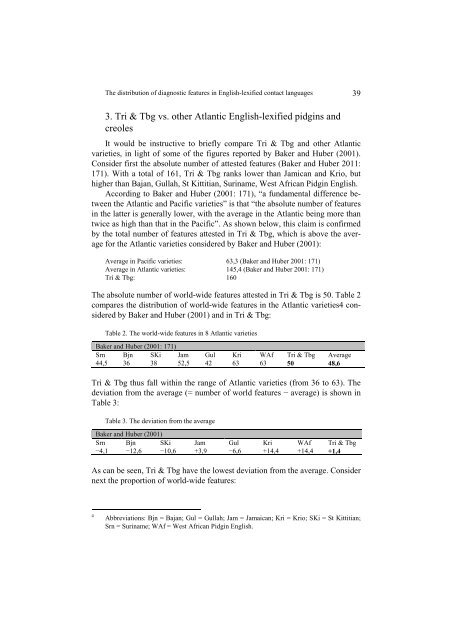s - Wyższa SzkoÅa Filologiczna we WrocÅawiu
s - Wyższa SzkoÅa Filologiczna we WrocÅawiu
s - Wyższa SzkoÅa Filologiczna we WrocÅawiu
You also want an ePaper? Increase the reach of your titles
YUMPU automatically turns print PDFs into web optimized ePapers that Google loves.
The distribution of diagnostic features in English-lexified contact languages 39<br />
3. Tri & Tbg vs. other Atlantic English-lexified pidgins and<br />
creoles<br />
It would be instructive to briefly compare Tri & Tbg and other Atlantic<br />
varieties, in light of some of the figures reported by Baker and Huber (2001).<br />
Consider first the absolute number of attested features (Baker and Huber 2011:<br />
171). With a total of 161, Tri & Tbg ranks lo<strong>we</strong>r than Jamican and Krio, but<br />
higher than Bajan, Gullah, St Kittitian, Suriname, West African Pidgin English.<br />
According to Baker and Huber (2001: 171), “a fundamental difference bet<strong>we</strong>en<br />
the Atlantic and Pacific varieties” is that “the absolute number of features<br />
in the latter is generally lo<strong>we</strong>r, with the average in the Atlantic being more than<br />
twice as high than that in the Pacific”. As shown below, this claim is confirmed<br />
by the total number of features attested in Tri & Tbg, which is above the average<br />
for the Atlantic varieties considered by Baker and Huber (2001):<br />
Average in Pacific varieties: 63,3 (Baker and Huber 2001: 171)<br />
Average in Atlantic varieties: 145,4 (Baker and Huber 2001: 171)<br />
Tri & Tbg: 160<br />
The absolute number of world-wide features attested in Tri & Tbg is 50. Table 2<br />
compares the distribution of world-wide features in the Atlantic varieties4 considered<br />
by Baker and Huber (2001) and in Tri & Tbg:<br />
Table 2. The world-wide features in 8 Atlantic varieties<br />
Baker and Huber (2001: 171)<br />
Srn Bjn SKi Jam Gul Kri WAf Tri & Tbg Average<br />
44,5 36 38 52,5 42 63 63 50 48,6<br />
Tri & Tbg thus fall within the range of Atlantic varieties (from 36 to 63). The<br />
deviation from the average (= number of world features − average) is shown in<br />
Table 3:<br />
Table 3. The deviation from the average<br />
Baker and Huber (2001)<br />
Srn Bjn SKi Jam Gul Kri WAf Tri & Tbg<br />
−4,1 −12,6 −10,6 +3,9 −6,6 +14,4 +14,4 +1,4<br />
As can be seen, Tri & Tbg have the lo<strong>we</strong>st deviation from the average. Consider<br />
next the proportion of world-wide features:<br />
4<br />
Abbreviations: Bjn = Bajan; Gul = Gullah; Jam = Jamaican; Kri = Krio; SKi = St Kittitian;<br />
Srn = Suriname; WAf = West African Pidgin English.
















